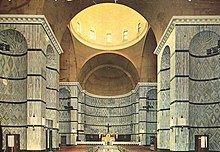|
Benghazi Cathedral
 Benghazi Cathedral (Arabic: كاتدرائية بنغازي) is a former Roman Catholic church in the city of Benghazi, Libya. It is located in the city center. HistoryBenghazi Cathedral, dedicated to the Holy Name of Jesus, was built between 1929 and 1939 on land formerly occupied by Arabs, and was one of the largest churches in North Africa.[1] It was designed by the Italian architects Ottavio Cabiati and Guido Ferrazza. It was lightly damaged when Benghazi was captured by the Wehrmacht during Operation Sonnenblume.[2] Soon after King Idris took power in 1951, the building was slowly abandoned due to lack of maintenance. After Muammar Gaddafi took power and suppressed the Libyan Church, plans were made to convert the building into a Mosque, as with the Cathedral of Tripoli, but the cathedral's position prevented Imams from facing Mecca, and the plans were scrapped.[3] The building was later used as a headquarters for the Arab Socialist Union.[4] The Headquarters had already been abandoned by time of the Libyan Civil War, following several unsuccessful restoration efforts. The Cathedral survived the Battle of Benghazi (2014–2017) without major structural damage.[5] In 2022, restoration works on the cathedral commenced. While municipal authorities stated that restoration works were being done in connection with the cathedral's status as a historic site, signage on the scaffolding of the cathedral indicated that the cathedral was, in fact, being converted into a mosque dedicated to Imam Malik ibn Anas. Locals alleged that the conversion was being done by the city's Awqaf Authority.[6] Architectural featuresThe building is an example of Neoclassical and Italian Fascist architecture. The cathedral's form is that of a basilica. The entrance has a portico with four Doric columns and two side pillars. Its two characteristic domes cover both spans of the nave, while a series of oculi provide the cathedral's lighting. Original plans show that the cathedral was not completed as planned; the designs included a three-story bell tower and sumptuous ceiling decoration, neither of which were built.[7] It is nonetheless one of the largest churches in North Africa.[citation needed] See alsoReferences
Wikimedia Commons has media related to Benghazi Cathedral. |
||||||||||||||||||||||||||||
